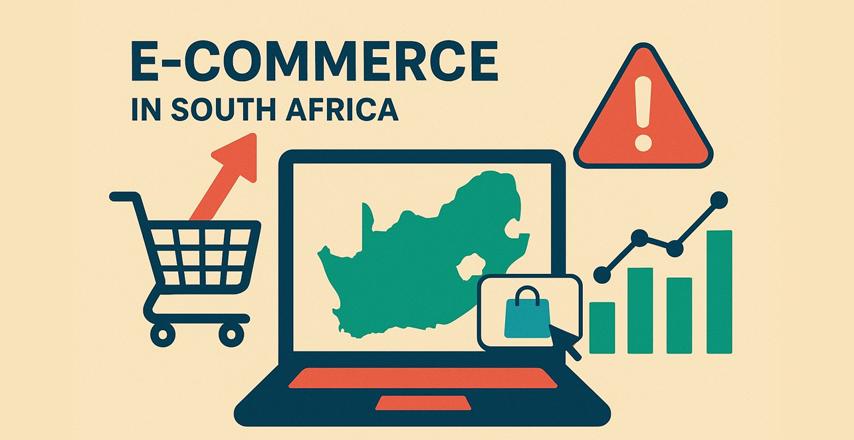
E-Commerce in South Africa: Growth, Barriers and Opportunities
Introduction
The e-commerce landscape in South Africa has undergone a remarkable transformation over the past decade, fuelled by rising internet accessibility, mobile adoption, and shifting consumer preferences. Leading this digital retail revolution are homegrown platforms like Takealot, which has emerged as the country’s largest online marketplace, alongside grocery delivery services such as Checkers Sixty60 and Pick n Pay ASAP. These players have not only normalised online shopping for millions of South Africans but have also set benchmarks for convenience, competitive pricing, and customer service.
However, the market is increasingly competitive, with international giants like Shein, Temu, and Amazon gaining traction due to their vast product ranges and aggressive pricing. While local retailers dominate frequent purchases, cross-border e-commerce presents both opportunities and challenges, such as import costs, logistical delays, and concerns over product authenticity.
This White Paper presents key findings from a comprehensive Vantage Point survey conducted by Bateleur Brand Planning, engaging 1,691 respondents across various demographics in the spring of 2024. The whitepaper investigates the state of South Africa’s e-commerce sector, analysing consumer behaviour, key barriers to growth, and strategies for local businesses to thrive in an evolving digital economy. By understanding these dynamics, stakeholders can better navigate the opportunities and challenges shaping the future of online retail in the region.
The Growth of E-Commerce in South Africa
Consumer Shopping Preferences
According to the vantage point data, South African consumers exhibit varied shopping habits: 37% mostly shop in-store, while 18% almost always do. Only 9% almost always shop online, and 16% mostly prefer online shopping. 20% balance both online and in-store purchases
equally.
This suggests that while brick-and-mortar retail remains dominant, a growing segment of consumers is embracing digital commerce. The mean score of 3.4 (on a scale where higher values indicate a preference for physical stores) indicates a gradual but steady shift towards online shopping.
Popular Online Retailers
South Africans frequently shop on both local and international platforms:
1. Regularly Used Online Stores (Monthly or More)
- Takealot (70%) leads as the most popular local e-commerce platform.
- Grocery delivery services like Checkers Sixty60 (40%) and Pick n Pay ASAP (33%) are widely used.
- International platforms such as Shein (27%), Temu (25%), and Amazon (14%) are gaining traction.
2. Occasionally Used Online Stores (Every 3 Months)
- Takealot (15%) remains prominent even for occasional shoppers.
- Clicks (14%) and
- Checkers Sixty60 (13%) also see moderate usage.
This data highlights the competitive landscape, where local retailers dominate frequent purchases, while international players attract shoppers for niche or discounted products.
3. The Rise of Cross-Border E-Commerce
A notable 72% of consumers hold a positive or somewhat positive sentiment toward purchasing from international retailers like Shein, Temu, and Amazon. However, concerns such as:
- Customs duties and import taxes (64%)
- Difficult return processes (61%)
- Product quality risks (56%)
- Limited consumer protection (54%)
act as deterrents. Despite these challenges, international retailers remain attractive due to lower prices (42%), broader product ranges (47%), and access to global trends (35%).
Barriers to E-Commerce Growth
1. Logistical and Operational Challenges Consumers expect improvements in:
Returns & Shipping:
- 51% demand easier, free return processes.
- 47% want cost-effective or free shipping thresholds.
- 39% seek faster delivery options.
Product Authenticity & Transparency:
- 44% desire assurance against counterfeit products.
- 44% need clearer product descriptions.
2. Trust and Payment Concerns
- 29% of consumers prefer flexible payment options (e.g., buy-now-pay-later).
- 38% want better customer support channels (live chat, phone).
- 37% emphasise the importance of genuine customer reviews.
3. Competition from International Retailers
While local businesses face pressure from global players, consumers acknowledge the following:
- Economic Impact: 53% believe international shopping harms local businesses.
- Ethical Concerns: 42% question whether foreign retailers enforce fair labour practices.
- Environmental Footprint: 30% recognise the higher carbon footprint of cross-border shipping.
Opportunities for Local E-Commerce Growth
1. Enhancing Customer Experience
Businesses can differentiate themselves by improving Loyalty Programs:
- 71% of consumers prefer cashback rewards.
- 64% value free shipping perks.
- 61% appreciate birthday rewards (Table 68).
Streamlining Checkout & Delivery:
- Implementing one-click purchasing (25% demand).
- Offering in-store pickup options (32% interest).
Leveraging Local Manufacturing Trust
- 77% of consumers trust South African-made products.
Businesses can capitalise on this by promoting locally sourced goods and transparent supply chains.
2. Adopting Hybrid Retail Models
- Click-and-collect and omnichannel strategies can bridge the gap between online and in- store shopping.
- Investing in AI-driven recommendations (19% demand) and virtual try-ons (23% interest) can enhance engagement.
3. Competing with International Retailers
- Price Matching: 39% of respondents want competitive pricing guarantees.
- Exclusive Local Products: Offering unique items not available on global platforms can attract shoppers.
Conclusion
South Africa’s e-commerce sector is poised for continued growth, but success hinges on addressing logistical inefficiencies, improving consumer trust, and leveraging local advantages. While international retailers present stiff competition, local businesses can thrive by focusing on superior customer experiences, loyalty incentives, and hybrid retail strategies.
By embracing innovation and consumer-centric approaches, South African e-commerce can unlock its full potential, driving economic growth and meeting the evolving needs of digital shoppers. Retailers can invest in seamless returns, loyalty programs, and faster shipping. The Government can also play a role by reducing import/export complexities to support cross-border trade. Logistics Providers can optimise last-mile delivery to enhance customer satisfaction and lastly, consumers can continue to support local businesses while advocating for better e- commerce policies.
